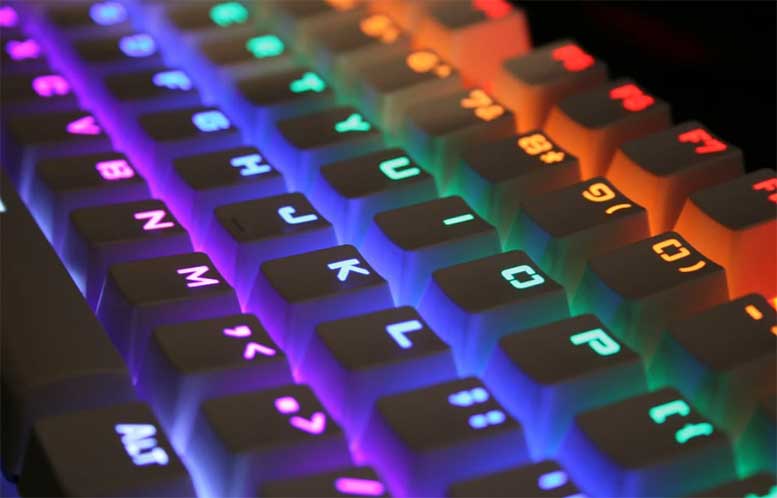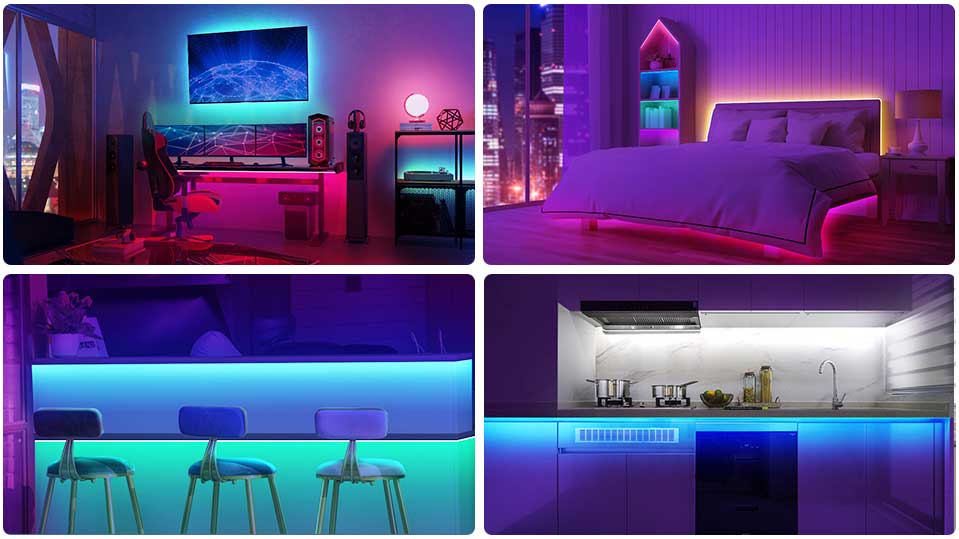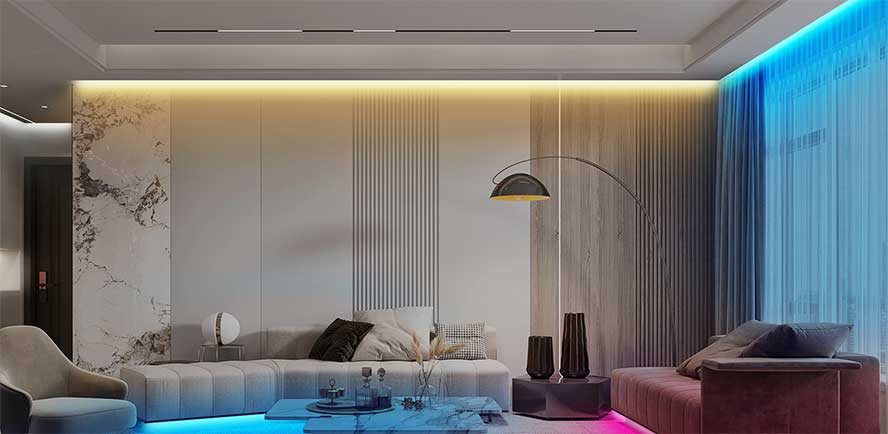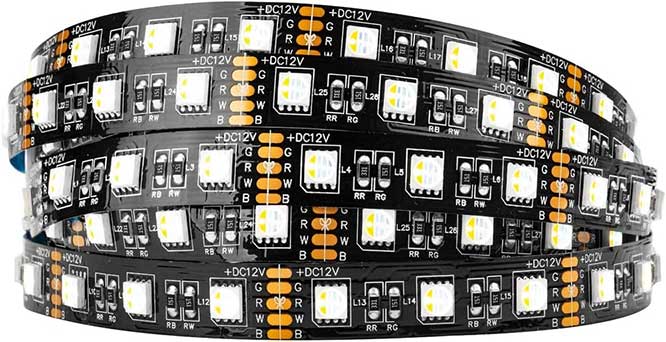In the world of LED lighting, the alphabet soup of acronyms can be confusing. RGB, RGBIC, RGBW, RGBWW – what do they all mean?
Today, we’re breaking down these terms to make your journey through the world of LED lighting a little less intimidating. Understanding these terms not only helps you know what you’re buying but also equips you with the knowledge to maximize the capabilities of your lights.
What Does RGB Stand For in LED Lighting?
Let’s start with the basics: RGB. The acronym RGB stands for Red, Green, and Blue. These are the three primary colors in LED lighting, and by controlling the brightness and mixing ratio of these colors, an RGB LED chip can emit a vast spectrum of colors.
In essence, RGB in LED lighting stands for color change, allowing you to customize your lighting experience to match your mood, event, or décor.
What Is RGBIC and How Does It Differ from RGB?
Next up, we have RGBIC. This term refers to IC-controlled RGB lights. IC stands for Integrated Circuit, and it is essentially a tiny brain that controls the light’s color and intensity.
In an RGBIC setup, each light can be controlled individually to display a specific color. This is different from traditional RGB, where all the lights change to the same color simultaneously.
RGBIC is also similar to other addressable LED formats like ARGB (Addressable RGB) and DRGB (Digital RGB). So, when you see terms like WS2812B, WS2811, WS2815, or SK6812, know that these are specific models of IC chips controlling the LED strips.

What About RGBW? How Is It Different from RGB?
RGBW adds another dimension to the color capabilities of LED lights. In addition to the standard RGB colors, an RGBW light also has a channel for pure white light. This allows for even more color-mixing possibilities and the option to produce pure white light.
The “W” in RGBW stands for white, offering the ability to create a more natural and brighter white light compared to an RGB strip, which produces a bluish-white light when all color channels are activated simultaneously.
RGBWW: What Does the Extra’ W’ Signify?
Adding another ‘W’ to the mix, we have RGBWW. This term represents RGB plus warm white light or RGB plus white and warm white light. The difference lies in the addition of an extra channel for white light.
In this case, RGBWW has more variations of white light than RGBW. Usually, RGBWW features one warm white and one daylight white light, providing you the freedom to adjust the light color temperature as per your needs.
RGBIC vs RGB: What’s the Real Difference?
While RGBIC and RGB might sound similar, they are fundamentally different in their color display capabilities. Thanks to the intelligent control chip in RGBIC lights, you can set the color of each LED individually.
This means you could have a rainbow of colors displayed at the same time. In contrast, with standard RGB strips (which are non-addressable), all lights must display the same color at once.
It’s crucial to note here that an RGBIC controller is not interchangeable with an RGB controller due to these differences in functionality.

RGB vs RGBW: Is There a Significant Difference?
The key difference between RGB and RGBW lies in their color mixing capabilities and the purity of white light. RGBW LED strips not only have a greater ability to mix colors but also have a pure white light channel. This offers a more natural white light, enhancing the overall lighting experience.
On the other hand, RGB can only produce a bluish-white light by activating all color channels simultaneously. So, if you’re looking for more color mixing options and a purer white light, RGBW would be the way to go.
RGBW vs RGBWW: Why the Extra’ W’?
We know that both RGBW and RGBWW have the capability to produce white light, but what distinguishes the two? The answer lies in the richness of the white light. RGBWW has an additional channel for white light compared to RGBW.
Typically, RGBWW contains two types of white light: warm white and daylight white. This allows for further customization of the color temperature to match your specific needs. Conversely, RGBW only has one white color temperature. Therefore, if you’re looking for more versatility in white light, RGBWW offers more options.

A Word About LED Controllers
Imagine having complete control of your LED lighting system with just one device. That’s where LED controllers come into play. These devices harness the power of pulse-width modulation (PWM) to adjust the brightness of your LEDs, and they come packed with features like color mixing and pre-programmed lighting effects.
LED controllers are versatile, finding use in both commercial and residential lighting applications. So whether you’re enhancing your home or lighting up a stage, an LED controller can help you create the perfect ambiance.
Key Differences Between LED Controllers
While all these LED controllers aim to provide you with a broad spectrum of color choices for your lighting setup, the key differences between them lie in the level of control and range of colors and effects they can offer:
RGB LED Controllers: RGB LED controllers are the baseline, controlling the red, green, and blue channels of RGB LED lights to create a variety of colors. They lack the ability to create white light or control individual LEDs, which the other controllers can do.
RGBW LED Controllers: These controllers add a white channel to the mix, enabling the creation of pure white light and enhancing color accuracy. This feature makes RGBW LED controllers superior to RGB controllers when it comes to simulating natural light or achieving more nuanced shades.
RGBIC LED Controllers: The standout feature of RGBIC LED controllers is their ability to control individual LEDs in an RGBIC light strip. This “individual control” makes it possible to create advanced lighting effects, including dynamic color changes and complex patterns, which the RGB and RGBW controllers cannot do.
RGBWW LED Controllers: RGBWW LED controllers are the most versatile, controlling RGB lights with not one but two types of white light – warm white and cool white. This expands the range of white tones achievable and allows for a more realistic replication of natural light, making these controllers the most advanced in terms of color and tone versatility.
While all four types of controllers offer color customization, their capabilities in terms of white light generation, individual LED control, and color versatility vary, with RGB being the simplest and RGBWW being the most complex. Your choice should depend on the level of control and the range of colors and effects you desire for your lighting setup.

How Do I Choose Between These LED Controllers?
Before investing in an LED controller, there are a few key factors you need to consider. Use the guidelines below to help you make the right decision.
Type of LED Lights: This should be your number-one priority. The LED controller you choose must be compatible with the LED lighting setup you wish to use.
Desired Lighting Effects: If you want basic color changes, an RGB controller should suffice. However, if you’re aiming for more nuanced colors, natural light replication, or complex lighting patterns, consider RGBW, RGBIC, or RGBWW controllers.
Smart Home Integration: Consider whether the controller is compatible with your existing smart home ecosystem. Some controllers allow for integration with devices like Amazon Alexa or Google Assistant for voice-activated control.
And finally, factor in the price and how much value the LED controller brings to the table. Comparing prices, features, and functionality can help you determine which controller best suits your needs.
How Do I Choose the Right Strip Lights for My Needs?
The type of LED strip lights you choose should depend on your specific lighting needs and preferences:
RGB LED Strips: These are great for creating a vibrant, colorful environment. They can display a wide range of colors but lack the ability to produce pure white light.
RGBW LED Strips: With the addition of a white channel, these strip lights are capable of creating a wider array of colors and white tones. As such, they’re a better fit for neutral or natural lighting schemes.
RGBIC LED Strips: These strip lights allow for the creation of complex lighting effects and patterns. If you’re after a dynamic, changing lighting atmosphere, RGBIC strip lights would be a good choice.
RGBWW LED Strips: These strip lights can create broad colors, including different shades of white light. They’re an excellent choice for creating natural, neutral, or warm white lighting effects.
Remember, the key is to consider what you’re hoping to achieve with your lighting setup. Different types of strip lights will lend themselves better to different applications and effects.

Final Thoughts
Understanding the terminology around LED lighting is crucial when deciding on the perfect lighting solution for your needs.
Whether it’s RGB, RGBIC, RGBW, or RGBWW, each type of light offers its own unique benefits and capabilities. RGBIC lights give you the freedom to individualize the color of each light, while RGBW and RGBWW bring the purity and variety of white light into the mix.
Remember, it’s not just about the lights themselves but the controllers too. An RGB controller won’t work with RGBIC lights, so make sure to get the right controller for your LED strip. When choosing between these options, consider what you want from your lights before making your purchase.
Meet Ry, “TechGuru,” a 36-year-old technology enthusiast with a deep passion for tech innovations. With extensive experience, he specializes in gaming hardware and software, and has expertise in gadgets, custom PCs, and audio.
Besides writing about tech and reviewing new products, he enjoys traveling, hiking, and photography. Committed to keeping up with the latest industry trends, he aims to guide readers in making informed tech decisions.

